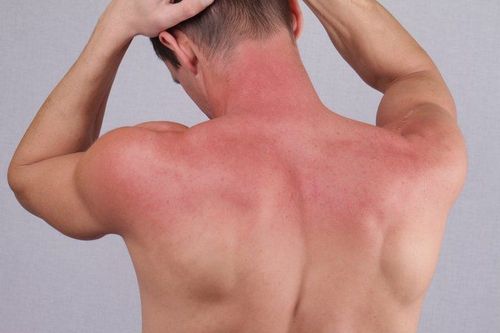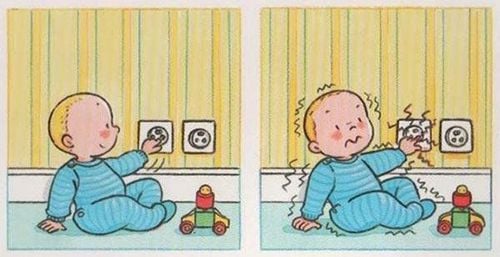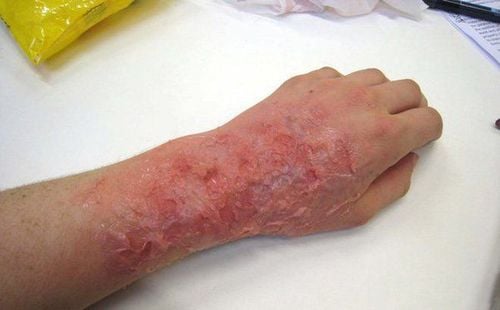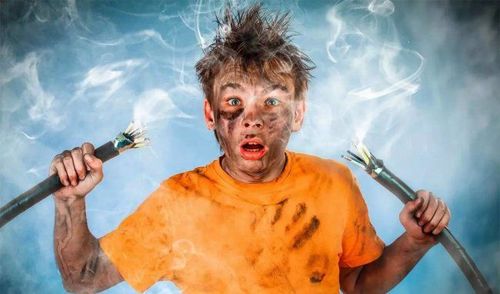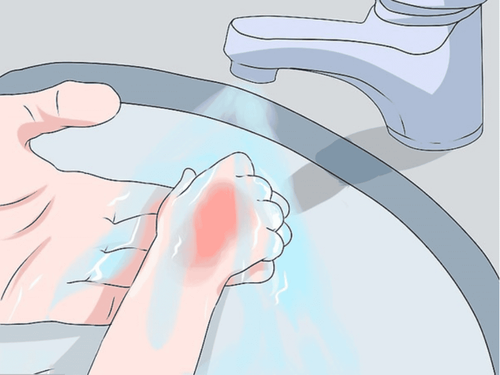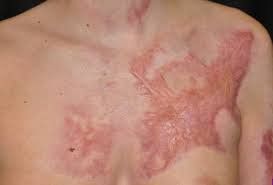This is an automatically translated article.
Children are inherently curious, as soon as they can walk they want to explore their surroundings. However, in the process of exploring them, they may come into contact with scalding agents such as fire, hot objects, etc., causing burns to children with varying degrees of severity.1. What is called a burn?
A burn is an injury to the skin or tissue caused by heat. It occurs when some or all of the cells in the skin or other tissues are destroyed by hot liquids, hot solids, or flames, injury from radiation, radiation, electricity, friction, or contact. with chemicals are also considered burns.2. Causes of Burns
Thermal burns are the most common type of burn. These burns occur when flame, metal, liquid, or steam come into contact with the skin. This can happen in many situations, including house fires, car accidents, kitchen accidents, electrical problems.>>> Correct first aid for potty and heat burns
In addition, there are other factors that can cause burns such as:
Radiation Heated objects The sun Electricity Chemicals Children are inherently curious curious, as soon as they can walk they want to explore their surroundings. However, in the process of exploring them, they may come into contact with burning agents such as fire, hot objects, ... causing children to suffer burns to different degrees.
3. Severity of the burn
Burn wounds are classified based on the depth of the skin damaged. The classification of burns may change within the first few days. This means that the burn may appear external at first, then the damage becomes deeper over time.Burn wounds are divided into 4 grades as follows:
First degree burns This is the mildest type of burn, only the outer layer of skin is damaged.
Symptoms of a child with a first degree burn include:
At the burn site, the skin is red and sometimes mildly swollen. The burn may look like a sunburn and it may whiten to light touch, but it does not develop into a blister. The top layer of skin may peel off in a day or two. Wounds usually heal after a few days.
2nd degree burns Injury deeper than first degree burns, resulting in blistering and swelling.
Symptoms of children with 2nd degree burns include:
2nd degree burns are also known as partial thick burns. Children are often very painful with a 2nd degree burn. The skin may be whiter to the touch and the blisters may ooze a clear liquid. Second-degree burns usually take a few weeks or more to heal, depending on the severity of the burn. The burned area may permanently become darker or lighter in color but does not form a scar.
Sunburn that blisters after a few hours is a good example of a 2nd degree burn.
3rd degree burn 3rd degree burn also known as deep partial thick skin burn, the burn spreads deeper into the skin, causing pain when pressed deep.
Symptoms of children with 3rd degree burns include:
The burned skin may be white or blackish. Your child may have less pain at first because the nerves are already damaged. The skin may be rough. Most third degree burns form blisters and do not turn white when pressed. Third-degree burns usually take more than 21 days to heal and often form a scar, which can be more severe.
An immediate blistering burn is a 3rd degree burn. A blister that persists for several weeks is also considered a 3rd degree burn.
4th degree burn A 4th degree burn, also known as a full-thickness burn, damages the skin. penetrates deeply through all layers of the skin, completely destroying the skin.
Symptoms of a child with a 4th degree burn include:
The burned area is usually painless, waxy white to skin gray or charcoal black. Skin is dry and does not darken to the touch. Recovery depends on the severity of the burn. Most wounds need to be treated with a skin graft.
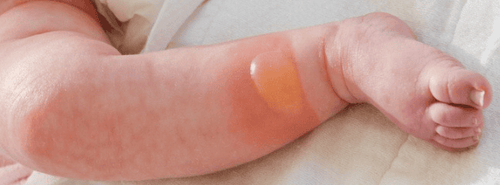
Vết thương bỏng được phân loại dựa trên độ sâu của vùng da bị tổn thương
4. What to do when detecting a child's burns?
When detecting a child with burns, you need to do the following immediately:Take the child away from the cause of burns, out of the danger zone. If your child's clothes catch on fire, put out the fire with a towel, blanket, or anything available around you like a coat, curtain, etc. Place a clean, sterile cloth over the burned area, if applicable. possible, but do not attempt to self-treat a serious burn. Do not directly touch or blow on the burn with your mouth as this can cause an infection to become more serious. 4.1. When to take the child to the doctor? Children with burns should be taken to the doctor in the following cases:
There is any additional injury other than a minor first-degree burn. The burn has penetrated the child's skin, causing a second-degree burn or higher. Burns larger than 2 inches (about 5cm) in diameter. Burns on the child's face, hands, feet, or genitals. 4.2. When to call an ambulance? You need to call 911 immediately if your child has the following symptoms:
The child is in shock: the child's skin is dark and pale, the lips or fingernails are bluish, the pulse is rapid, the breathing rate is rapid, the pupils are dilated or weak, the child's pupils are dilated or weak. dizzy or very nervous or afraid. Children have 3rd degree burns, 4th degree burns. Children have chemical or electrical burns. Large burn area. If your child covers their mouth and nose with their hands, they may have burned their airways and you need to call 911 right away. If the child is burned and the child stops breathing, you need to have someone call 911 immediately, while you need to start CPR on the child. If you are there alone, give CPR within two minutes first, then call 911.
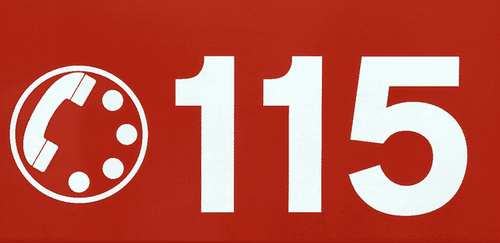
Nếu trẻ bị bỏng và trẻ ngừng thở, bạn cần phải bảo ai đó gọi cấp cứu ngay, trong khi đó bạn cần bắt đầu hô hấp nhân tạo cho trẻ
Cleaning the wound : Remove clothing from the burned area. If clothing sticks to the skin, do not try to remove it, but take the child to a medical facility immediately. Gently wash the burned area with cool tap water and plain soap. It is not necessary to disinfect the skin with alcohol or other cleaning agents.
Cooling the skin: After cleaning the skin, you can apply a cold compress to the skin or soak the area in cool water (not ice) for a short time to relieve pain and reduce the degree of burns for the child. Avoid placing ice directly on the skin as this can unintentionally further damage the skin. Prevent infection: To prevent infection in a deep burn, you can apply aloe vera or an antibiotic cream, such as Bacitracin. Do not apply ointments or other substances such as mustard, egg white, lavender oil, emu oil, toothpaste... Keep the burn clean by washing the burned area daily with soap and water. Mild burns can be covered with a bandage if you wish. Burns that form blisters should be left clean. You need to replace it once or twice a day for your baby.
You need to try to keep the child from bursting the blisters as this can increase the risk of skin infection. Let the blister burst and ooze out
Tetanus prevention : If your child has not been vaccinated against tetanus in the last 5 years and the burn is 2nd degree or higher, you need to get your child vaccinated against tetanus. Treat pain: you can give your child an over-the-counter pain reliever such as Acetaminophen or Ibuprofen if needed to relieve pain. If you have used these medicines and your child still does not feel better, you need to take your child to the hospital. Severe burns or large burns may require a prescription for pain medication.
Avoid scratching the skin : During a burn, your child may feel itchiness in the burned area as the wound begins to heal. You need to try to avoid the child scratching, this helps the wound to heal faster. You can use moisturizers, antihistamines to relieve itching.
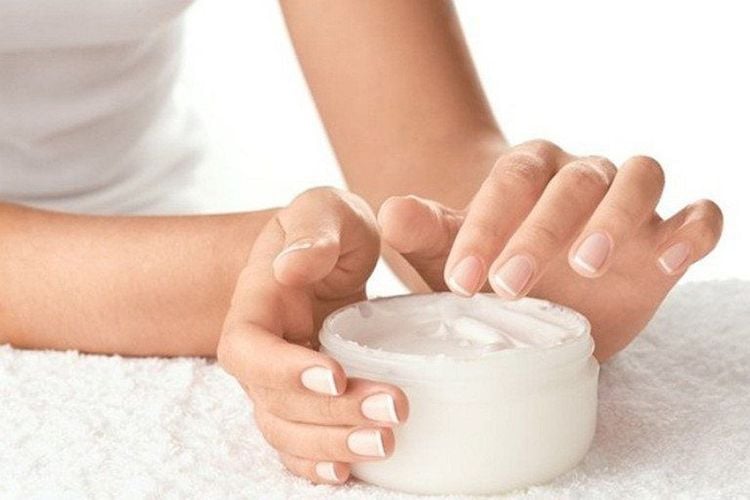
Bảo vệ vết bỏng tránh khỏi ánh nắng mặt trời trong một năm, bằng kem chống nắng hoặc quần áo
When detecting a child has a chemical burn, you need to do the following immediately:
Take off the child's clothes if the chemical is still on it, cut off the clothes if necessary. If the chemical is as dry as a powder, find a safe way to remove it from the child's skin such as wearing gloves,... Rinse the burned area with cool water for at least 15 minutes and wash it off gently with soap and water. Be careful not to get the chemical in your child's eyes. Gently pat dry with a clean cloth. Cover the wound with a dry and sterile bandage. Do not use cotton as it may stick to the wound. If chemical splashes into eyes, flush eyes for 20 minutes under cool running water. Do not apply any lotion or ointment. Get your child to the hospital quickly in the following cases:
Chemical burns have penetrated the child's skin causing second-degree burns or higher. Burns larger than 2 inches in diameter. Burns on hands, feet or genital area. Chemical splash in eyes, need to wash eyes for 20 minutes, then take the child to the hospital. 4.5. How to recognize an infected burn If your child has a burn and has the following signs of infection take him or her to the hospital right away:
Pain increases. The burn is excessively swollen. Swollen wound The degree of redness of the wound increases. A blister filled with brown or green discharge. The burn is draining fluid or pus. There is a strange smell from the burn. Children with swollen lymph nodes. Fever child. Red spots spread from the burn. 4.6. Measures to prevent scarring from burns in children To reduce the risk of scarring, you need to cover the burned area of your child's skin until the skin has healed and is free of water. Protect burns from the sun for a year, with sunscreen or clothing.
Severe burns are more likely to leave scars than minor burns.
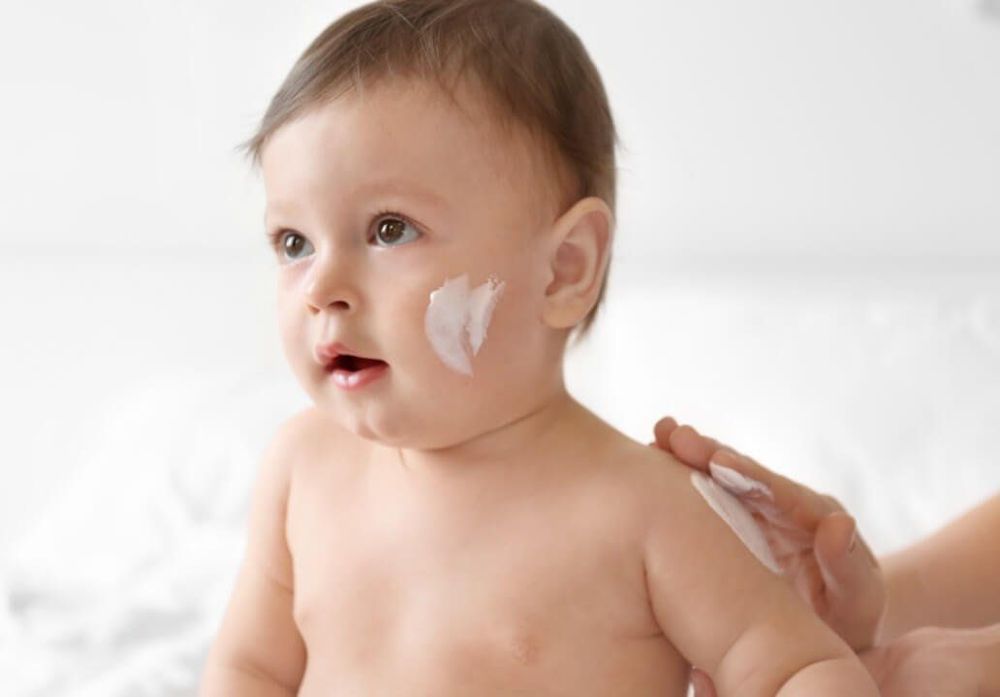
Bảo vệ vết bỏng tránh khỏi ánh nắng mặt trời trong một năm, bằng kem chống nắng hoặc quần áo
5. Measures to prevent burns in children
Children's skin is thinner than adult skin, so it is more susceptible to burns. Children under the age of 4 are also at greater risk of complications from burns. Things you need to do to reduce your child's risk of burns are:Never leave cooked food on the stove when your child is around. Do not hold children while cooking. When cooking, it is necessary to turn the handles of pots and pans inward, to avoid children reaching up and spilling hot food on them. Don't let your baby sit on your lap while drinking hot drinks and don't try to hold them with one hand and hot drinks in the other. Place hot food and drinks away from the edges of tables and counters. Do not place them on pads or tablecloths that children can pull down. To reduce the risk of burns in the bath, set your hot water to no more than 48oC. Teach your child not to touch the faucet handle while in the shower. Keep irons, curling irons, lit candles and potential burn hazards out of the reach of children. Use fireplace screens in front of your fireplace and keep your children out of the area. Keep in mind that it takes more than an hour for a gas heater to cool completely once it's turned off. Keep your child away from wood stoves, fireplaces, and barbecues. Cover electrical outlets with socket covers and keep cords out of reach of children. Check your child's car seat before putting him in it. Check the temperature of metal toys and equipment such as slides or swings before putting your child on it. Do not use a microwave oven to warm baby bottles or other beverages. Use a cooling nebulizer or humidifier. Keep the steam generator away from your child. Heat burns are a common cause of accidental death in children worldwide. The best way to protect your child is to keep them away from burns, keeping them within your sight at all times.
Please dial HOTLINE for more information or register for an appointment HERE. Download MyVinmec app to make appointments faster and to manage your bookings easily.
Article references sources: babycenter.com, webmd.com, uptodate.com, mayoclinic.org, who.int



